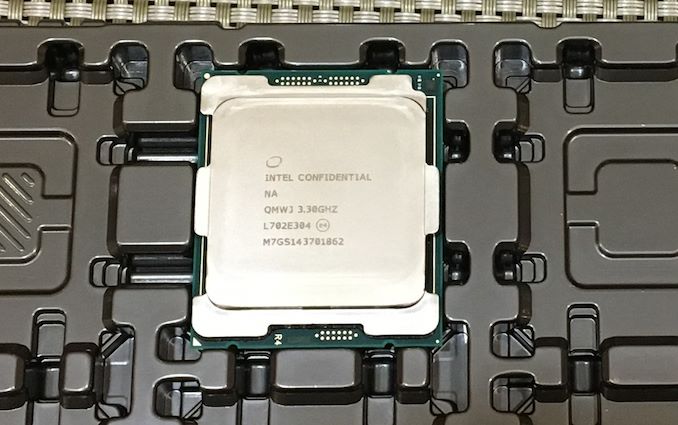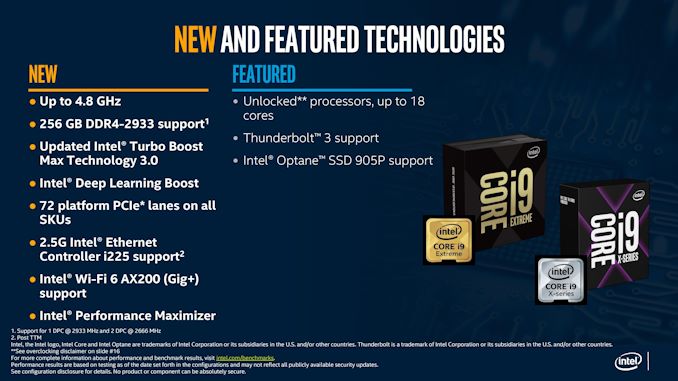Intel's Cascade Lake-X CPU for High-End Desktops: 18 cores for Under $1000
by Dr. Ian Cutress on October 1, 2019 6:35 PM EST- Posted in
- CPUs
- Intel
- HEDT
- LGA2066
- Cascade Lake

With someone in the press having broken their embargo earlier today, Intel is lifting the lid earlier than planned on their upcoming Cascade Lake-X family of processors for the high-end desktop (HEDT) market. Similar to the way Intel's Cascade Lake based Xeon Scalable processors are a further revision of their Skylake Xeons, offering clock speed increases and security fixes in hardware, the new HEDT processors will grant higher frequencies, more memory capacity, and better protection against side-channel attacks. The key numbers however are the big drop in Intel's pricing: Intel will be releasing its 18-core part, the Core i9-10980XE, for under $1000.
| Intel Cascade Lake-X | |||||||
| AnandTech | Cores Threads |
Base | All Core |
TB2 | TB3 | TDP | Price (1ku) |
| Core i9-10980XE | 18C / 36T | 3.0 | 3.8 | 4.6 | 4.8 | 165 W | $979 |
| Core i9-10940X | 14C / 28T | 3.3 | 4.1 | 4.6 | 4.8 | 165 W | $784 |
| Core i9-10920X | 12C / 24T | 3.5 | 4.3 | 4.6 | 4.8 | 165 W | $689 |
| Core i9-10900X | 10C / 20T | 3.7 | 4.3 | 4.5 | 4.7 | 165 W | $590 |
| Skylake-X (previous generation) | |||||||
| Core i9-9980XE | 18C / 36T | 3.0 | 4.5 | 4.7 | 165 W | $1979 | |
| Core i9-9940X | 14C / 28C | 3.3 | 4.5 | 165 W | $1387 | ||
| Core i9-9920X | 12C / 24T | 3.5 | 4.5 | 165 W | $1189 | ||
| Core i9-9900X | 10C / 20T | 3.5 | 4.5 | 165 W | $989 | ||
This pricing is a significant shift in Intel's strategy, and a number of fingers will be pointed at AMD as having made this happen. Next month AMD is set to launch its 16-core Ryzen 9 3950X at $749, which will offer 16 PCIe 4.0 lanes for slots (+4 for M.2, +4 for chipset) and support for 128 GB of DRAM. So Intel needed something similarly speedy, but with more PCIe lanes and more memory support that they could offer for just a bit more, leading to the 10980XE for $979. Ultimately, the on-shelf price is often just slightly higher than tray price, so don't be surprised if retail prices land at around $1000.
All the CPUs will support 256 GB of quad-channel memory (up from 128 GB), and have 48 PCIe 3.0 lanes (up from 44). Memory speed support is listed as DDR4-2933 for 1 DIMM per channel, and DDR4-2666 for 2 DIMMs per channel. All these CPUs have a TDP of 165 W, which Intel states will help the CPUs to turbo longer under Intel's recommended settings (as we know, consumer motherboard manufacturers like to ignore these anyway). All these CPUs are supported in X299 motherboards.
There is no 16-core in this stack, with Intel's official reasoning being that they assess the market with each generation and they don't believe there's a suitable price point for such a part when the 14C and 18C parts are so close. Most people will point the finger and say that no-16 core Intel part means no direct comparison with the Ryzen 9 3950X, which is something to think about.
Another point to note is that Intel has stopped this stack at the 10 core and no lower. This means that there will be no cross over between Intel's consumer processor stack and the HEDT stack, with users needing to spend just a little bit more from the Core i9-9900K/KF to reach up to the Core i9-10900X. It will be interesting to see where Intel's Core i9-9900KS fits in, although that still only has dual channel memory and 16 PCIe 3.0 lanes.
Intel lists Wi-Fi 6 and 2.5GbE support on these new processors - to clarify, Intel means external controllers here. For some odd reason when Intel says support, it could mean internal to the chipset or external via a controller; this is messaging I've railed against for a while, as it ends up confusing for enthusiasts, especially when this is an enthusiast platform. It does mean however that we get official information about Intel's 2.5GbE controllers, which we've been waiting on for a couple of years. Intel stated that these controllers will be ready at a later date, and more information to follow. (The controllers are currently listed on Intel's ARK database, but as 1 GbE controllers for some reason.)
These CPUs will have the same security mitigations as the Cascade Lake Xeon processors, with updated hardware mitigations for a number of side channel attacks. We are waiting to hear from Intel if the firmware that supports these processors will also have additional fixes in for Zombieload by default.
One question about this launch is surrounding Intel’s 14nm capacity. Within the last week, there have been reports that despite Intel’s best efforts and promises to match demand, and that Q3 and upcoming for Q4 is going to be busier than expected. We reached out to Intel last week for clarification, and the company said that the bulk of its capacity is focusing on the high-end processors in the market: the Xeon Scalable, the Core i9, Core i7, and Core i5. It will be interesting to see if launching another family of products is going to put additional strain on Intel’s capacity and demand.
With AMD's recent Zen 2 Ryzen 3000 series launch on 7nm earlier in the year, Threadripper 3 coming later this year, and Intel swinging another generation of 14++ into the high-end desktop market, Intel is going to have some tough times. Don't get me wrong, this pricing update from Intel is a good thing for users, especially those looking at implementing things like DL Boost to their workflow, but this market is suddenly turning very aggressive, and it will be interesting to see if Intel can be agile enough to keep pace.
Intel's Cascade Lake-X processors will be available in November. More details should be released nearer to launch.











162 Comments
View All Comments
danielfranklin - Tuesday, October 1, 2019 - link
Looking good!Who would have thought another Intel 14nm respin would be exciting!
Pity they arent going to re-release some cheaper 2066 Xeon-W chips now Xeon-W has moved to another socket.
Ive got a nice Xeon-W machine that would have loved a ~$1000 drop in 18 core upgrade :P
shabby - Tuesday, October 1, 2019 - link
Now do the same for the non-hedt chipsQuantumz0d - Tuesday, October 1, 2019 - link
I do not understand one thing - Turbo limits out of factory aka Intel recommended vs Motherboard enhancement whining, so much noise about the damn TDP, as if the K series or X series Unlocked processors are going to run like puny crap like Laptops which have Power Limits hardcoded in EC and BIOS like Apple Trashbook Pro or thin and light junk cTDP BGA garbage.Intel got away with it but the user is getting MAX perf OOTB or they can customize it, why sandbang it with bullshit limits and whining.
Quantumz0d - Tuesday, October 1, 2019 - link
*K or X are being run in an ITX mini box size of a lunch box and have crippled cooling, that user should really be educated or not worth owning such Processors. I have UV and Turbo OC with more Current Limits which allows me to run higher Turbo clocks and I did that manually, which got me 700CBR15 score, vs a 600OOTBSpunjji - Wednesday, October 2, 2019 - link
It's not about "bullshit limits and whining" - it's about Intel giving us honest estimates of power consumption under load. I think most of us are fine with them drawing more power to hit the top speeds on many cores, but it'd be nice if they gave a useful estimate of what that power draw would be before purchase, instead of them hiding behind the meaningless "165W TDP".Also, funny point - the problem with the "Trashbook Pro" isn't a hardcoded power limit, it's the lack of one. When the 6 core i9 CPU came along and blew past its spec, it triggered protections elsewhere in power delivery (and cooling). Blaming Apple for Intel's CPU operating way outside spec is a bit of a reach.
Bear in mind that I still think Apple screwed the pooch, both by making their devices unnecessarily thin and by failing to catch that issue in qualification.
rahvin - Wednesday, October 2, 2019 - link
TDP's should be maximum output to make heatsink selection easier.Putting the TDP of the chip as some middle of the road TDP and concealing the max TDP only makes it harder for consumers for no gain other than marketing. It's stupid and foolish and Intel should be called out for doing it.
What Intel is doing is what happens when Marketing decides on what technical specifications to reveal. Your average consumer isn't concerned at all if a chip has a higher TDP, so this is only a lie targeting enthusiasts who actually care to know the real TDP.
The_Assimilator - Wednesday, October 2, 2019 - link
> Bear in mind that I still think Apple screwed the pooch, both by making their devices unnecessarily thin and by failing to catch that issue in qualification.You assume Apple does any sort of testing, as opposed to throwing their overpriced s**t over the wall and letting their hordes of drones drown out any complaints with "IT JUST WORKS!!!!!"
bji - Wednesday, October 2, 2019 - link
Then don't buy their products. And don't post your drivel here. No loss to Apple, and no loss to Anandtech readers.Quantumz0d - Wednesday, October 2, 2019 - link
I hope their LGA3647 socket W 3175X sees same price cuts and gets the damn Dominus Extreme into more audience. But it's a shame that X299 saw so many Processors while Z390 is being discarded again, sad. I wanted to build a PC this Fall, wanted Win7 and top class Perf with old and new games, Z390 Dark was my build with 2070Super but now with Z490 on the horizon Intel doesn't inspire confidence, though these processors with X299 Dark at low cost makes it superb given this time the Mesh keeps up with the Ring bus 9700K at-least.Plenty of time to wait for 3900X and 3950X in Stock and price drop for X570 Aorus Extreme vs X299 or Z390 or Z490.. ;)
twtech - Wednesday, October 2, 2019 - link
They have a new W3275 already available, but instead of becoming cheaper, it's more expensive.